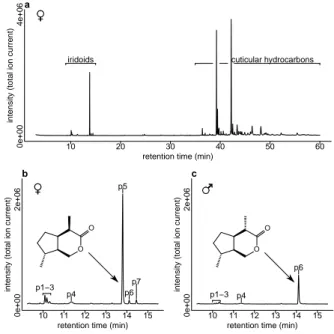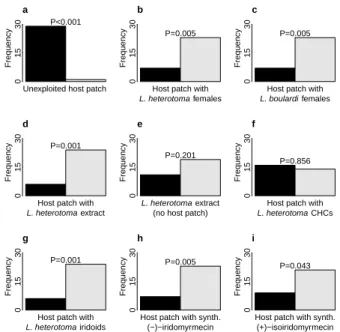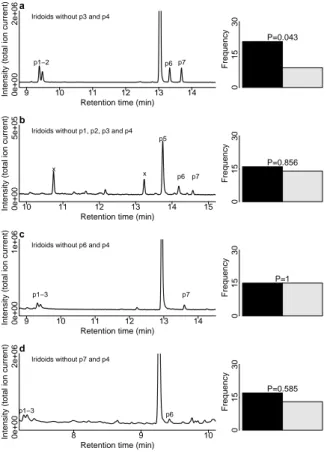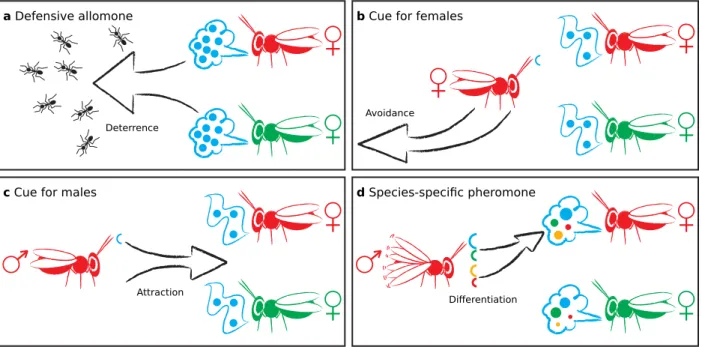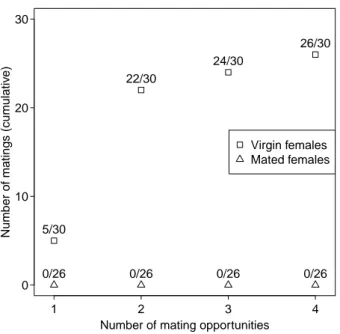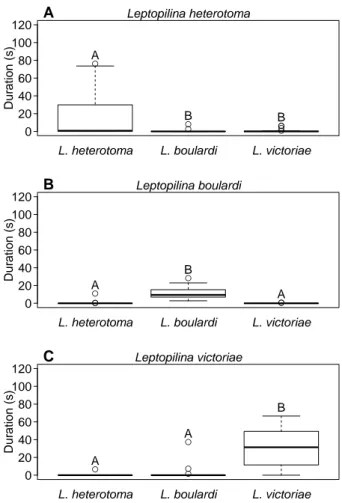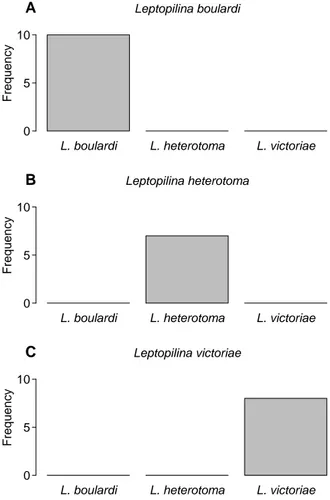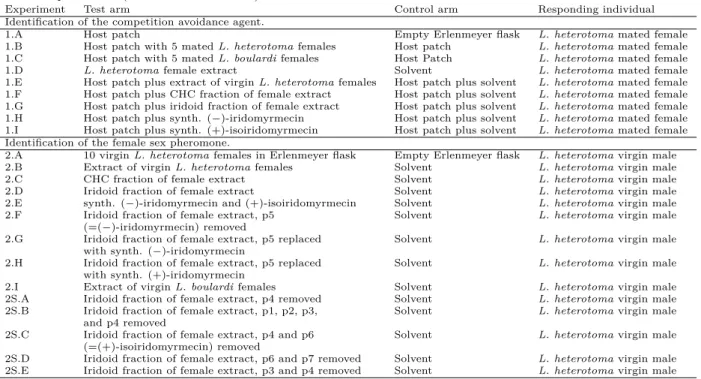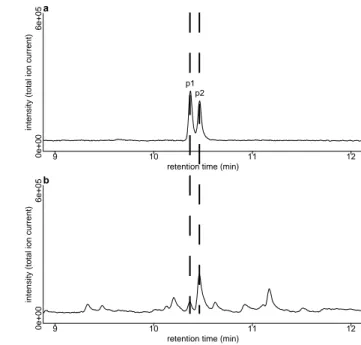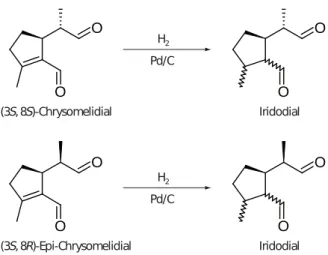Figitidae), a parasitoid of Drosophila
DISSERTATION ZUR ERLANGUNG DES DOKTORGRADES DER NATURWISSENSCHAFTEN (DR. RER. NAT.)
DER FAKULTÄT FÜR BIOLOGIE UND VORKLINISCHE MEDIZIN DER UNIVERSITÄT REGENSBURG
vorgelegt von
Ingmar Weiss
aus Augsburg
im Jahr 2015
Die Arbeit wurde angeleitet von:
Dr. Johannes Stökl Unterschrift:
Ingmar Weiss
Chapter 2 has been published as Weiss, I., Rössler, T., Hofferberth, J., Brummer, M., Ruther, J., and Stökl, J. A nonspecific defensive compound evolves into a competition avoidance cue and a female sex pheromone. Nature Communications, 4, 2013. doi: 10.1038/ncomms3767. This chapter is licensed under the Creative Commons Attribution-NonCommercial-ShareAlike 3.0 Unported license. To view a copy of the license, visit https://creativecommons.org/licenses/by-nc-sa/3.0/
legalcode.
Author contributions: I.W., J.R., and J.S. designed the study; I.W. (sex pheromone identification), T.R.
(competition avoidance agent identification), M.B. (headspace), and J.S. (species specificity) performed the experiments; J.H. synthesized the compounds; I.W., J.H., J.R., and J.S. wrote the manuscript.
Chapter 4 has been published as Weiss, I., Hofferberth, J., Ruther, J., and Stökl, J. Varying importance of cuticular hydrocarbons and iridoids in the species-specific mate recognition pheromones of three closely relatedLeptopilina species. Frontiers in Ecology and Evolution, 3 (19), 2015. doi: 10.3389/fevo.2015.00019. This chapter has been licensed under the Creative Commons Attribution 4.0 International license. To view a copy of the license, visithttps://creativecommons.org/
licenses/by/4.0/legalcode.
Author contributions: I.W., J.R., and J.S. designed the study; I.W. performed the experiments; J.H. syn- thesized the compounds; I.W., J.H., J.R., and J.S. wrote the manuscript.
List of publications 3
List of figures 5
List of tables 6
Summary 7
1. General introduction 8
2. The evolution of mate attraction and competition avoidance inLeptopilina heterotoma 12 3. Mating frequency and post-mating attractiveness ofLeptopilina heterotoma females 24 4. Species specificity and chemical diversity of mate recognition 28 5. Species specificity of the putative male antennal aphrodisiac pheromone 37
6. General discussion 41
References 47
Acknowledgements 55
A. Supplementary information for chapter 2 56
B. Supplementary information for chapter 4 64
C. Experimental parameters for the investigation of mate attraction inLeptopilina heterotoma 69
2.1. Chromatograms ofL. heterotomafemale extract and iridoid fractions ofL. heterotomafemale
and male extract . . . 14
2.2. Bioassays conducted to identify the competition avoidance cue inL. heterotoma. . . 16
2.3. Bioassays conducted to identify the female sex pheromone inL. heterotoma . . . 16
2.4. Bioassays conducted to demonstrate the importance of minor components of the female sex pheromone inL. heterotoma . . . 17
2.5. Dose-response experiments for the sex pheromone inL. heterotoma . . . 17
2.6. Species specificity and released amounts of the sex pheromone inL. heterotoma . . . 17
2.7. Pheromone evolution inLeptopilina. . . 19
3.1. Proportion of matedL. heterotomafemales that elicited courtship in naiveL. heterotomamales 26 3.2. Number ofL. heterotoma females that had mated after a given number of mating opportunities 26 4.1. Duration of wing fanning displayed by males towards con- and heterospecific females . . . 32
4.2. Duration of wing fanning displayed by males towards conspecific extract and fractions thereof 34 5.1. Number of conducted replicates until courtship was observer 10 times in the mating trials . . 39
5.2. Frequency of males that elicited readiness to mate in con- and heterospecific females . . . 39
A.1. Mass spectra of p1 and p2 . . . 57
A.2. Chromatogram of p1 and p2; non-polar column . . . 57
A.3. Chromatogram of p1 and p2; cyclodextrin column . . . 57
A.4. Hydrogenation of (epi-)/chrysomelidial . . . 58
A.5. Mass spectra of p7 . . . 59
A.6. Chromatogram of p7; non-polar column . . . 59
A.7. Chromatogram of p2; cyclodextrin column . . . 59
A.8. Chemical compounds produced by L. boulardi . . . 60
A.9. Chromatogram of (−)-iridomyrmecin inL. boulardi; non-polar column . . . 60
A.10.Chromatogram of (−)-iridomyrmecin inL. boulardi; polar column . . . 61
A.11.Chromatogram of (−)-iridomyrmecin inL. boulardi; cyclodextrin column . . . 61
A.12.Stereochemical analysis of the Diels-Alder reaction . . . 62
A.13.Impurities in the authentic standard of (−)-iridomyrmecin . . . 63
C.1. Frequency of males attracted towards female-derived extract in y-tube bioassays at different times during the photoperiod . . . 71
C.2. Decision times of males in y-tube bioassays at different times during the photoperiod . . . 71
A.1. Species specificity of mate recognition . . . 56 A.2. Behavioural assays . . . 56 B.1. Statistical details for the analysis of courtship duration towards conspecific and heterospecific
females . . . 64 B.2. Iridoids found in females ofL. heterotoma,L. boulardi, andL. victoriae . . . 65 B.3. CHCs found in females ofL. heterotoma,L. boulardi, andL. victoriae . . . 65 B.4. Statistical details on the pairwise comparisons of courtship duration towards extract, fractions,
and control for L. heterotoma . . . 68 B.5. Statistical details on the pairwise comparisons of courtship duration towards extract, fractions,
combined fractions, and control for L. boulardi . . . 68 B.6. Statistical details on the pairwise comparisons of courtship duration towards extract, fractions,
and control for L. victoriae . . . 68
Animal communication systems employ a variety of different modalities, including visual, acoustic, elec- trical, and chemical stimuli. In insects, the use of chemicals for information transfer, the so-called se- miochemicals, is a common phenomenon.
In this doctoral thesis, I investigate the chemical communication of the genus Leptopilina, a genus of solitary parasitoids ofDrosophila. I mainly study the sexual communication of the closely related species L. heterotoma, L. boulardi, and L. victoriae, with particular emphasis on mate attraction, mate recog- nition, and receptiveness elicitation.
In chapter 2, I identify the female mate attrac- tion pheromone of L. heterotoma. The pheromone is composed of several iridoids; its main component is (−)-iridomyrmecin, which is also shown to medi- ate competition avoidance in host-searching females.
Because (−)-iridomyrmecin has previously been iden- tified as defensive compound of L. heterotoma, an evolutionary route can be hypothesised, leading from the defensive function to competition avoidance and mate attraction pheromone accompanied by an in- crease in specificity and complexity of the semiochem- ical blend.
In chapter 3, I investigate the mating frequency and post-mating attractiveness of L. heterotoma fe- males. Previous studies by different authors men- tioned that females are monandrous and lose their attractiveness after mating. These reports, however, rely on incidental observations rather than dedicated experiments. I show, through a series of mating trials that L. heterotoma females are indeed monandrous, but do not lose their attractiveness. The found mon- andry implies the need for species-specific mate re- cognition inL. heterotoma, and the post-mating at- tractiveness is interpreted as a side effect of the parsi- monous use of iridoids inL. heterotoma.
In chapter 4, I study the species specificity and chemical diversity of the female mate recognition pheromones ofL. heterotoma,L. boulardi, andL. vic- toriae. Mating trials with conspecific and heterospe- cific females show that mate recognition is highly spe- cies specific in the three species. I then continue to in-
vestigate the chemical composition of the female mate recognition pheromones. InL. heterotoma, mate re- cognition is mediated by iridoids alone, whereas in L. victoriae, cuticular hydrocarbons are of major im- portance. The picture is yet different inL. boulardi: iridoids and cuticular hydrocarbons are equally im- portant in mate recognition. The chemical diversity of the mate recognition pheromone very likely ensures its species specificity.
In chapter 5, I show the species specificity of the putative male antennal aphrodisiac pheromones in L. heterotoma,L. boulardi, andL. victoriae. For this, I devise a setup, in which the odour profile of hetero- specific females is manipulated, so that the females are recognized as conspecifics by males. Males read- ily court heterospecifics in this setup, but can elicit receptiveness only in conspecific females. The iden- tity of the putative aphrodisiac pheromones is not investigated, but the setup can likely be used to test candidate compounds for their behavioural activity.
The results presented in this thesis provide new insights into the evolution of chemical communic- ation in Leptopilina. The suggested evolutionary route from defensive compound to mate attraction pheromone in L. heterotoma strongly supports the hypothesis that communicative functions can evolve for non-communicative compounds—and that thus the composition of chemical signals may be partially predestined by an inventory of non-communicative compounds. A similar inventory of such non- communicative compounds, however, does not ne- cessarily lead to the same pheromone composition.
In the investigated Leptopilina species, the female mate recognition pheromones differ greatly between the species. This supports the hypothesis that signals under strong stabilizing selection can evolve through saltational shifts, thus allowing rather drastic changes despite strong stabilisation. Building upon the new insights presented here, the chemical communication of more Leptopilina species should now be invest- igated to further advance our understanding of the evolution of chemical communication.
Communication in animals
Communication in animals is an intensely researched topic. What exactly defines communication, how- ever, is debatable. According to Scott-Phillips (2008), communication is often defined in terms of either adaptions or information transfer. Scott- Phillips himself defines communication (in terms of adaptions) as
‘[t]he completion of corresponding signals and responses.’
A ‘signal’ is defined as
‘[a]ny act or structure that (i) affects the behaviour of other organisms; (ii) evolved because of those effects; and (iii) which is effective because the effect (the response) has evolved to be affected by the act or structure’
and a ‘response’ is defined as
‘[a]ny act or structure that (i) is the ef- fect of some act or structure of another organism; (ii) evolved to be affected by that act or structure; and (iii) which is affected because the other act or struc- ture (the signal) has evolved to affect this act or structure.’
According to Endler (1993), animal communica- tion enables individuals to base decision on the beha- viour or physiology of others. This implies, that dur- ing communication, information is transferred (via a signal, as defined above) from one individual (the
‘sender’) to another (the ‘receiver’). According to Endler (1993), the evolution of the signal increases communication efficiency and the benefit the sender receives from the receiver’s response, and the evolu- tion of the receiving mechanisms increases efficiency and reliability of the signal’s perception.
The term ‘signal’ needs to be very clearly differen- tiated from the term ‘cue’. A signal has evolved to al- ter the behaviour of other organisms (and is effective because a response evolved in the receiver), and be- cause a signal requires adaptations in both sender and receiver, a benefit for both is implied. Cues, on the other hand, have not evolved to cause a response, and do not necessarily benefit the sender. Scott-Phillips (2008) defines a ‘cue’ as
‘[a]ny act or structure that (i) affects the behaviour of other organisms; and (ii) which is effective because the effect has evolved to be affected by the act or struc- ture; but which (iii) did not evolve be- cause of those effects.’
Cues are e. g. chemical compounds that are employed by the sender for non-communicative functions, in- cluding defensive secretions, cuticular compounds, and hormones, and that are released into the envir- onment. Information transfer only takes place be- cause the receiver ‘eavesdrops’ on the available cue and infers information from it. If a cue benefits the sender, the cue will likely evolve into a signal optim- ized for information exchange (Sorensen and Stacey, 1999; Steiger et al., 2011; Weiss et al., 2013; Wyatt, 2014).
Chemical communication in insects
Chemical communication, i. e. communication that employs chemical compounds to transfer informa- tion, is considered to be the oldest and most wide- spread form of communication (Wyatt, 2003). Al- though insects use a variety of sensory modalities for communication, chemical communication can be found throughout the insect taxa and is therefore in- tensely investigated. Chemical compounds employed for information transfer are called ‘semiochemicals’, regardless of being a signal or a cue. Semiochemicals are divided into ‘pheromones’ that mediate intraspe- cific information transfer and ‘allelochemicals’ that mediate interspecific information transfer (Nordlund and Lewis, 1976).
Allelochemicals are further divided into ‘allomones’
that benefit only the sender, ‘kairomones’ that bene- fit only the receiver, and ‘synonomes’ that benefit both sender and receiver (Nordlund and Lewis, 1976;
Wyatt, 2014).
Pheromones can be further divided into primer pheromones that cause a developmental process in the receiver and releaser pheromones that cause a specific behavioural reaction in the receiver (Wyatt, 2014). Additionally, pheromones can be further di- vided by their behavioural function. This includes, e. g. aggregation, recruitment, alarm, and sex pher- omones (Tillman et al., 1999).
To date, thousands of pheromones have been iden- tified in a number of different taxa, including mam- mals, reptiles, and insects (El-Sayed, 2014). Pher- omones fulfill a number of different roles, including the elicitation of alarm behaviour (e. g. in bees), the guiding of nestmates to a food source (e. g. in ants), the marking of a territory (e. g. in canines), and the attraction of mates (e. g. in moths). In fact, the very first pheromone to be identified was the sex pher- omone of the silkworm, Bombyx mori (Butenandt et al., 1959). A pheromone may consist of only one single compound or a mixture of several compounds, the number of components reaching over a dozen in some pheromones (Wyatt, 2014). Pheromones can be practically applied in pest management, e. g. as attractants in traps to monitor pest populations or in techniques to limit reproduction in pest species, such as ‘mating disruption’.
Parasitoids
A parasitoid can be defined (Eggleton and Gaston, 1990) as
‘an organism which develops on or in an- other single (“host”) organism, extracts nourishment from it, and kills it as a dir- ect or indirect result of that development.’
The above definition does not restrict the term para- sitoid to insect taxa, as is often the case (Eggleton and Gaston, 1990). Parasitoid lifecycles are com- monly found in insects, but Hymenoptera show an especially high proportion of parasitoid species (Eggleton and Belshaw, 1992). In fact, 70 % of the about 95 000 Hymenoptera species are parasitoids and make up about 80 % of all parasitoids (Eggleton and Belshaw, 1992). Hosts of parasitoids are usually other insects, but numerous species of other Arthro- poda have been found to be hosts as well (Eggleton and Belshaw, 1993). Despite the large number of parasitic Hymenoptera, only a small number of their sex pheromones have been identified to date (Ruther, 2013).
Sexual communication in parasitoids
In insects, sexual communication, i. e. communica- tion that ultimately occurs for the purpose of mat- ing, heavily relies on sex pheromones (Godfray, 1994;
Quicke, 1997). Sex pheromones fulfill a variety of functions. They mediate mate attraction, mate re- cognition, mate assessment, and receptiveness elicit- ation. Mate attraction pheromones are released by one sex and enable the other sex to locate potential mating partners over some distance, they are usu- ally effective at long range. At close range, mate re- cognition pheromones enable individuals to identify other individuals as conspecific members of the op- posite sex, i. e. as a suitable mate. Mate recognition
pheromones usually elicit stereotyped courtship be- haviour in one or both sexes. Courtship is typically required to elicit readiness to mate in the female sex.
During courtship, individuals can assess the quality of the other individual as a mate. This is especially important for females, as they usually have a greater interest than males to only copulate with a suitable male of high quality, so they will produce high qual- ity offspring (Andersson, 1994). Once a female has accepted a male as mate, the female will indicate its receptiveness and copulation will eventually occur.
A species may possess different pheromones for the functions mentioned above, but a single pheromone can also fullfil more than one function. Furthermore, sexual communication may consist of not only pher- omones, but can include signals from other sensory modalities (Andersson, 1994).
The genus Leptopilina and its ecology
Wasps of the genus Leptopilina Förster, 1862 are solitary parasitoids of Drosophilid flies. The genusLeptopilinais currently comprised of 32 species (Nordlander, 1980; Quinlan, 1988; Nordlander and Grijpma, 1991; Allemand et al., 2002; Novkovic et al., 2011; Forshage et al., 2013; Wachi et al., 2015), some of which have been classified into 3 species groups within the genus: thelongipes group, theheterotoma group, and the boulardi group (Nordlander, 1980).
Members of theheterotoma group are mainly found in the Oriental region, whereas species from theboul- ardi group occur mainly in Africa. Species from the longipesgroup appear in Europe, South America, and the Carribean. Although several morphological and genetical phylogenies have been described (van Al- phen et al., 1991; Schilthuizen et al., 1998; Allemand et al., 2002; Novkovic et al., 2011), these phylogenies have a low resolution and only low statistical support.
Also, none of the published phylogenies includes all Leptopilina species, but only varying subsets of the known species.
Females ofLeptopilinalay their eggs into early in- star larvae ofDrosophila. As most parasitoids, Lep- topilina species tend do parasitize larvae of only one or very fewDrosophilaspecies. The tight interaction of Leptopilina and Drosophila has made the genus Leptopilina a model organism to study host-parasite interactions. Most studies, however, focused on the immune defense ofDrosophilaagainst theLeptopilina larvae (Fleury et al., 2009). The wasps’ ecology has so far been studied with respect to host searching behaviour, foraging strategies, and patch time al- location (Fleury et al., 2009; Kaiser et al., 2009).
However, only little is known about mate finding, mate recognition, and courtship behaviour of Lep- topilina, three levels of sexual communication that often involve sex pheromones in parasitic Hymenop-
tera (Ruther, 2013).
Drosophilaspecies, the host species ofLeptopilina, are usually no pests. Thus, a potential role ofLepto- pilinain pest control had not been investigated until recently. With the emergence of Drosophila suzukii in Europe and North America (Hauser, 2011; Calab- ria et al., 2012), however, the situation has changed.
In contrast to most otherDrosophila species,D. su- zukiifemales possess a serrated ovipositor (Cini et al., 2012). Thus,D. suzukii females can lay eggs into un- damaged fruit, thereby damaging the fruit and even- tually ruining crops, while most otherDrosophilaspe- cies can lay their eggs only into already damaged or overripe fruits or mushrooms (Cini et al., 2012). Dro- sophila suzukiiis the only knownDrosophilapest spe- cies, and it is rapidly emerging in Europe and North America (Hauser, 2011; Calabria et al., 2012). This has lead to first initial investigations into the poten- tial role of parasitoids, includingLeptopilina, as ant- agonists againstD. suzukii(Chabert et al., 2012). To establishLeptopilinaas a control agent ofD. suzukii, however, in-depth knowledge of the ecology, including the chemical ecology, ofLeptopilina is required. This is particularly true for ecological aspects of reproduc- tion, such as mate attraction, mate recognition, and courtship behaviour, but also for host-finding and competition avoidance mechanisms. The mechanisms for host-finding and competition avoidance inLepto- pilinacan be exploited to direct parasitoids towards specific areas in the field. Detailed knowledge of the mating behaviour allows efficient rearing of the para- sitoids, e. g. aphrodisiac pheromones can be used to increase receptiveness in females and thereby increase the number of offspring per generation. Thus, thor- ough knowledge of the chemical ecology ofLeptopilina is required to efficiently rear and deploy Leptopilina as a potential control agent ofD. suzukii.
Leptopilina heterotoma(Thomson, 1862) andLep- topilina boulardi (Barbotin, Carton & Kelner- Pillaut, 1979) females have been found to orient- ate towards odours specific toDrosophila (Wiskerke et al., 1993; Hedlund et al., 1996). More specifically, host-searching females eavesdrop on the aggregation pheromone of their host species to find hosts for ovi- position.
Competition avoidance in host-searching Lepto- pilinafemales has been investigated by Janssen et al.
(1995a,b). They found that, in the field, host- searchingL. heterotomafemales avoided host patches that were already exploited by Leptopilina clavipes females. Subsequently, Janssen et al. could show in laboratory experiments that this avoidance is odour- mediated and that the avoidance behaviour is not only interspecific, but also intraspecific. The identity of the avoidance-inducing odour, however, has not been investigated so far.
Fauvergue et al. (1999) found that males of both L. heterotomaandL. boulardiwere attracted towards female-baited traps in orchards. In wind tunnel ex- periments, Fauvergue et al. (1999) could demonstrate that a volatile sex pheromone is responsible for the attraction of males towards females. The compos- ition of the sex pheromone, however, has not been investigated so far.
The mating behaviour of L. heterotoma has been described by several authors (Jenni, 1951; van den Assem, 1968; Isidoro et al., 1999). Males typically display wing-fanning, a high-frequency vibration of the wings, when they recognize a female. After their recognition, males approach the female and then touch the female with the antennae. Afterwards, the female is mounted. Once the female has been mounted, it usually folds back its antennae, so the male’s head comes to lie between the female anten- nae. Males then show so-called antennal stroking (or paddling), moving their antennae in a circular pattern, thereby bringing their own proximal anten- nomeres into contact with the female’s distal anten- nomeres in a rhythmical way. The female may then accept the male as mate. If the male is accepted, the female will lower her antennae and open her genital orifice (and extrude the ovipositor, personal obser- vation). The male then moves backwards and even- tually copulation occurs. Wing fanning is typically maintained during all stages of courtship and stops only when copulation occurs or courtship is aban- doned. I found that the mating behaviour ofL. boul- ardi and Leptopilina victoriae Nordlander, 1980 is very similar to that of L. heterotoma. The role of pheromones in elicitation of both male courtship and female receptiveness has not been investigated so far, although a male antennal aphrodisiac pheromone has been proposed (Isidoro et al., 1999).
Thesis outline
In this work, the sexual communication and compet- ition avoidance behaviour of the species L. hetero- toma, L. boulardi, and L. victoriae is investigated.
Both L. heterotoma and L. boulardi have a cosmo- politan distribution (Nordlander, 1980) whileL. vic- toriae is restricted to Africa (Nordlander, 1980) and Asia (Novkovic et al., 2011).
In chapter 2, the composition of the female mate attraction pheromone in L. heterotoma is investig- ated. Additionally, the competition avoidance odour is identified and the evolutionary pathway that might have lead to the composition of the pheromone is dis- cussed.
In chapter 3, the mating frequency of L. hetero- toma females and the loss of attractiveness of mated females that has been postulated in previous studies are studied.
In chapter 4, the species specificity of the mate recognition pheromones of L. heterotoma, L. boul- ardi, andL. victoriaeis investigated. Furthermore, a high chemical diversity of the mate recognition pher-
omones is demonstrated.
In chapter 5, the species specificity of the putative male antennal aphrodisiac pheromone of L. hetero- toma,L. boulardi, andL. victoriaeis shown.
competition avoidance in Leptopilina heterotoma
This chapter has been published asWeiss, I., Rössler, T., Hofferberth, J., Brummer, M., Ruther, J., and Stökl, J. A nonspecific defensive compound evolves into a competition avoidance cue and a female sex pheromone. Nature Communications, 4, 2013. doi: 10.1038/ncomms3767. The chapter is licensed under the Creative Commons Attribution-NonCommercial-ShareAlike 3.0 Unported License. To view a copy of the license, visit https://creativecommons.org/licenses/by-nc-sa/3.0/
legalcode.
Author contributions: I.W., J.R., and J.S. designed the study; I.W. (sex pheromone identification), T.R.
(competition avoidance agent identification), M.B. (headspace), and J.S. (species specificity) performed the experiments; J.H. synthesized the compounds; I.W., J.H., J.R., and J.S. wrote the manuscript.
The evolution of chemical communication and the origin of pheromones are among the most challen- ging issues in chemical ecology. Current theory predicts that chemical communication can arise from compounds primarily evolved for non-communicative purposes but experimental evidence showing a gradual evolution of non-informative compounds into cues and true signals is scarce. Here we report that females of the parasitic waspLeptopilina heterotoma use the defensive compound (−)-iridomyr- mecin as a semiochemical cue to avoid interference with con- and heterospecific competitors and as the main component of a species-specific sex pheromone. Although competition avoidance is mediated by (−)-iridomyrmecin alone, several structurally related minor compounds are necessary for reliable mate attraction and recognition. Our findings provide insights into the evolution of insect pher- omones by demonstrating that the increasing specificity of chemical information is accompanied by an increasing complexity of the chemical messengers involved and the evolution of the chemosensory adaptations for their exploitation.
Introduction
Chemical senses are the oldest and most widespread in nature and chemical communication was likely the original mechanism of information transfer between individuals (Wyatt, 2003). One major advantage of chemical communication is the enormous diversity of potential signals. To date, several thousand chemical pheromone components (chemical signals used for in- traspecific communication) are known to science (El- Sayed, 2009–2013), and using these compounds in combination results in an astounding collection of possible chemical signals.
What is the origin of a chemical signal and what qualifies a certain compound to be used as a pher- omone? Even considering all of the physiological and physical limitations, such as the availability of chem- ical precursors and biosynthetic pathways or func-
tional signal constraints such as volatility, hundreds or thousands of different chemical compounds would be equally well suited as messengers. Thus, other factors must have a role in the evolution of such sig- nals.
Current evolutionary theory predicts that pher- omones may evolve from compounds already in use for non-communicative functions (Steiger et al., 2011;
Bradbury and Vehrencamp, 2011; Wyatt, 2010). For example, hormones, defensive secretions, or cuticular compounds can be the basis for pheromone evolu- tion. If these compounds, or their metabolites, are released by one individual and perceived by another individual, they might provide information about the condition of the sender. This condition can be the simple presence of the sender or, in the case of hor- mones, a physiological state (Sorensen and Stacey,
1999). A compound perceived in this way serves only as a cue: it supplies information without being selec- ted for this function. If the sender benefits from the receiver’s response, chemical ritualization may alter the status of the cue into a true signal by it being selected for information transfer (Steiger et al., 2011;
Tinbergen, 1952).
The use of a chemical substance for two or more purposes is well established and referred to in the lit- erature as ‘semiochemical parsimony’ (Blum, 1996).
Classic examples of primarily non-communicative compounds becoming informative in intraspecific interactions are cuticular hydrocarbons (CHCs).
Found on the cuticle of almost every insect, CHCs function primarily as a desiccation barrier (Gibbs, 1998). But in addition, CHCs serve as semiochem- ical cues (for example, nestmate recognition in social insects) or have even evolved into signals (Howard and Blomquist, 2005), and in some cases, the se- lective forces driving this process have been identi- fied (Steiner et al., 2005; Ruther and Steiner, 2008;
Kühbandner et al., 2012). Defence compounds are also candidate chemicals that may be employed for intraspecific information transfer. To fulfil their func- tion, they are typically produced and released in re- latively large quantities and thus are often easily de- tectable. Consequently, defensive compounds have been found to function as alarm pheromones (for example, (Löfqvist, 1976)) or even more specifically as sex pheromones (Ruther et al., 2001; Geiselhardt et al., 2008; Boppré, 1986). However, most studies in- vestigating multi-functional defence compounds are limited to the description of the multiple functions of the compounds but do not address the ecological framework that might have favoured their evolution.
In particular, it is unclear how an increase in spe- cificity and information reliability is achieved when defence compounds evolve into chemical signals, be- cause the same defence chemicals are often used by several species (Laurent et al., 2005). One way the specificity and reliability of the information could in- crease is via species-specific alterations of the chem- ical messengers. Such alterations could include the presence and relative proportion of other compounds in the blend. However, to the best of our knowledge, experimental evidence for this type of signal evolu- tion is missing.
Leptopilina heterotomais a solitary larval parasit- oid of Drosphilid flies, includingDrosophila melano- gaster (Jenni, 1951; Hedlund et al., 1996). Ow- ing to the model status of its host, Leptopilina has been intensively studied during the past years (re- viewed in Fleury et al. 2009). Recently we have shown that females and males ofL. heterotoma pro- duce iridomyrmecins in a cephalic gland and that the wasps use it as a repellent against insect pred-
ators (Stökl et al., 2012). Furthermore, it is known, that females ofL. heterotomaare able to distinguish between host patches with and without conspecifics, based on olfactory cues only (Janssen et al., 1995a).
Iridomyrmecin is the major volatile compound pro- duced by L. heterotoma and therefore it is a likely candidate to serve as a competition avoidance cue for female L. heterotoma. Males and females of L. het- erotoma use different stereoisomers of iridomyrme- cin for defence. While females produce (−)-irido- myrmecin and, in much smaller quantities (+)-iso- iridomyrmecin (Stökl et al., 2012), males produce only (+)-isoiridomyrmecin. This sex-specific differ- ence and the observation that males are attracted to virgin females by olfactory signals (Fauvergue et al., 1999) suggest that (−)-iridomyrmecin, in addition to its defensive function, might also be the female sex pheromone inL. heterotoma.
In this study, we present a case of threefold semi- ochemical parsimony in L. heterotoma and provide evidence for the evolution of a nonspecific defens- ive compound into an agent mediating inter- and intraspecific competition avoidance and a species- specific female sex pheromone. This increased spe- cificity of information is accompanied by a diversi- fication of the chemical messengers and behavioural adaptations.
Results
Chemical analysis. To identify the chemical cues and pheromone compounds mediating competition avoidance and mate finding, we extracted the wasps in dichloromethane (DCM). The extract contains iridoids and CHCs (fig. 2.1a). We subsequently frac- tionated the extract into CHCs and iridoids by solid phase extraction or size-exclusion chromatography (SEC). The iridoid fraction contained (−)-iridomyr- mecin as major component (fig. 2.1b, ‘p5’ and (+)-isoiridomyrmecin ‘p6’ as a minor component. In addition, three further iridoids (‘p1’, ‘p2’, ‘p7’) were present in small amounts.
Mass spectra of p1 and p2 were very similar to a published mass spectrum of iridodial (fig. A.1a–c, Ohmura et al. 2009) suggesting that p1 and p2 are stereoisomers of iridodial. As synthetic references for iridodial were not available, we produced them by catalytic hydrogenation of (epi-)/chrysomelidial (fig. A.4) extracted from Phaedon cochleariae lar- vae. Two iridoidials formed by hydrogenation of (epi-)/chrysomelidial showed mass spectra identical to those of p1 and p2, respectively (fig. A.1d, e). Ad- ditionally, these iridodials co-eluted with p1 and p2 on a non-polar GC-column (fig. A.2). One of the (epi- )/chrysomelidial-derived iridodials co-eluted with p2 also on the Beta DEX 225 column (fig. A.3). We conclude from these results that p1 and p2 are irido-
dials. We suggest that p2 is identical to one of the (epi-)/chrysomelidial-derived iridodials, whereas p1 is likely the enantiomer of one of the other iridodials formed by hydrogenation of (epi-)/chrysomelidial.
retention time (min)
intensity (total ion current)
10 20 30 40 50 60
0e+004e+06
a
iridoids cuticular hydrocarbons
retention time (min)
intensity (total ion current)
10 11 12 13 14 15
0e+002e+06
b
p1−3 p4
p5
p6 p7 O
O
retention time (min)
intensity (total ion current)
10 11 12 13 14 15
0e+002e+06
c
p1−3 p4
p6 O
O
Figure 2.1.: Chemical compounds produced by L. hetero- toma. Total ion current chromatograms of (a)L. heterotoma female extract and the iridoid fraction of (b) female and (c) male extract. Compound p5 is (−)-iridomyrmecin and p6 is (+)-isoiridomyrmecin. The inserts in (b) and (c) show their structure and absolute configuration. Compounds p1 and p2 were tentatively identified as iridodials; p7 was tentatively identified as a third iridomyrmecin. P3 and p4 were beha- viourally inactive and thus not identified.
Peak p7 showed a mass spectrum similar to (−)-iridomyrmecin (fig. A.5a, b) suggesting that p7 is another stereoisomer of iridomyrmecin. Mass spectra of trans-fused stereoisomers of iridomyrmecin show different mass spectra (m/z 95 is always smaller than m/z 81, fig. A.5c, Hilgraf et al. 2012) and we thus excluded the presence of these compounds. From the eight possible cis-fused stereoisomers of iridomyrme- cin we excluded (+)- and (−)-iridomyrmecin and (+)- and (−)-isoiridomyrmecin because of differing reten- tion times compared with authentic standards. Thus, four possible cis-fused iridomyrmecin stereoisomers remained as possible structures for p7. Although, those were not available as pure synthetic references, p7 co-eluted with a minor impurity in the synthetic sample of (−)-iridomyrmecin on both the non-polar BPX-5 (fig. A.6) and the Gamma DEX 120 column (fig. A.7). This impurity shows the same mass spec- trum as p7 (fig. A.5a, d). We therefore conclude that p7 is the same compound as the impurity in the synthetic sample. The way we synthesized (−)-irido- myrmecin suggests that this impurity, and therefore
p7, is either (4R,4aS,7R,7aR)- or (4S,4aS,7R,7aR)- iridomyrmecin (J and K in fig. A.13). The line of argumentation for this conclusion is provided in de- tail below.
Two further minor compounds in the iridoid frac- tion (‘p3’,‘p4’) were found to be behaviourally inact- ive (see below) and were thus not structurally elu- cidated. Unlike (−)-iridomyrmecin and (+)-isoirido- myrmecin the minor compounds in p1, p2 and p7 were not available as synthetic standards. To test their contribution to the biological activity, we isol- ated them from the iridoid fraction by preparative gas chromatography. The two iridodial (p1 and p2) could not be further seperated and were thus tested together in the bioassays. The CHC fraction was be- haviourally inactive and thus not analysed any fur- ther.
We used femaleL. boulardiand extracts thereof to test the species-specificity of the chemical communic- ation in L. heterotoma. Leptopilina boulardi occurs sympatrically withL. heterotomaand parasitizes the same host species (Hedlund et al., 1996; Fauvergue et al., 1999). Our chemical analysis revealed that the females of L. boulardi produce the same iridoid compounds asL. heterotomafemales, but in different ratios (figs. A.8–A.11).
Detailed argumentation for the identity of p7. Be- cause of the way the authentic standards of (−)-irido- myrmecin and (+)-isoiridomyrmecin were prepared, certain minor impurities are likely to contaminate the authentic standards.
Authentic standards of (−)-iridomyrmecin and (+)-isoiridomyrmecin were prepared using a highly diastereoselective synthesis. The stereochemistry in the final products is governed by the stereochem- istry of the single stereocenter in the starting ma- terial. The parlay of stereochemistry from the C7 stereocenter in citronellal to the bridgehead positions (C4a and C7a) occurs during formation of the five- membered ring. This reaction is thought to occur by a concerted hetero-Diels-Alder reaction because only products with a cis ring junction have ever been observed. With a stereocenter at C7, there are two distinct transition states for the Diels-Alder reaction that have different energies (fig. A.12). The forma- tion of the trans cis product (A) is presumably fa- vourable both kinetically because of the lower en- ergy transition state and thermodynamically because there is less steric compression compared with the al- ternative cis cis product (B). As first described by Schreiber et al. (1986), the ratio of A to B strongly fa- vours A under both kinetic and thermodynamic con- ditions. Specifically, he found that the ratio of A to B at short reaction times to be about 4:1. If the re-
action is allowed to continue for long reaction times, the ratio of A to B increases to >20:1. We have used this method to generate the iridoid carbon framework extensively and have never isolated B and because it forms in such small proportions with respect to A, we have not seen evidence of it in our spectral analysis.
Chances are high that the cis cis diasteromer B is present in our product mixtures albeit in very small relative amounts. In contrast, there is little chance that the cis trans or trans cis isomers (fig. A.12, in the box) will form because of the stereospecificity of the concerted Diels-Alder reaction.
The stereochemistry of the stereocenters at C4a, C7 and C7a do not change during the remainder of the synthesis of iridomyrmecin and isoiridomyrmecin.
However, the stereocenter at C4 is generated with low selectivity later in the synthesis (fig. A.13). During the hydration of C (and D), the C4 and C3 stereo- centers are formed in all possible orientations. Using silica gel chromatography, the hydrated products E and G can be separated. Because we do not detect the alternate products derived initially from B (via D), F and H, we cannot determine whether either F and/or H is/are present as impurities in E or G. So when E and G are separately oxidized to form (−)-iridomyr- mecin and (+)-isoiridomyrmecin, we cannot say if J and/or K is/are present as very minor impurities.
In summary, although the authentic standards of (−)-iridomyrmecin and (+)-isoiridomyrmecin are very pure (>99%), it is possible that two side products, J and K, formed during their synthesis. Al- though it is possible that one or both of these side products are present, it is very unlikely that the cor- responding cis trans or trans cis isomers (derived from the intermediates in the box in fig. A.12) are present.
Because a very minor component (p7) of the nat- ural blend rich in (−)-iridomyrmecin co-elutes with a very minor impurity in the authentic standard of (−)-iridomyrmecin and has an identical mass spec- trum, it is likely the identity of the minor component (p7) is either J or K.
When the authentic standard of (−)-iridomyr- mecin is injected with the natural compounds, the minor impurity in the authentic standard co-elutes with p7 on both non-chiral (fig. A.6) and chiral columns (fig. A.7). This is consistent with the idea that p7 forms as a side product during the biosyn- thesis of the (−)-iridomyrmecin in the insect pro- duced blend. One would not expect the insect to pro- duce the enantiomer of p7 (called here ent-p7). This enantiomer (ent-p7) would be indistinguishable from p7 on the non-chiral GC-column but not on a chiral phase GC-column. The enantiomers of J and K, ent- J and ent-K, would be expected as minor impurit- ies in the preparation of (+)-iridomyrmecin. There- fore, one would anticipate that the minor impurity in
(+)-iridomyrmecin will co-elute with p7 on the non- chiral column and not co-elute on the chiral phase column. This expected result is borne out by experi- ment further supporting that p7 is J and/or K.
All lines of evidence support that p7 is J and/or K. Our understanding of the synthesis of (−)-irido- myrmecin implicates J and K as likely impurities in the authentic standard. Without the isolation and full characterization of the impurity, we cannot prove that J and/or K are the structures we propose but it is highly likely based on the chemistry.
Competition avoidance cue. Having the volatiles produced byL. heterotomaat hand, we used a y-tube olfactometer to test the hypothesis that the iridoids, particularly (−)-iridomyrmecin , mediate competi- tion avoidance in host-searching females ofL. hetero- toma. In a first basic experiment, we demonstrated that mated female L. heterotoma prefer host patch odour to clean air (fig. 2.2a). In subsequent experi- ments, the responding females had the choice between the odours of two host patches, one with females, one without. Females avoided the already exploited host patches, irrespective of whether conspecific (fig. 2.2b) or heterospecific (fig. 2.2c) females were present and preferred the host patch without wasps. Next, we replaced the living females on the host patch with an extract ofL. heterotomafemales. The host patch with the female extract was avoided by the females (fig. 2.2d), but the extract was not avoided if presen- ted without a host patch (fig. 2.2e). The com- pound(s) responsible for this effect were present in the iridoid fraction of the female extract, whereas the CHC fraction was behaviourally inactive (figs. 2.2f–
2.2g). Finally, we added synthetic (−)-iridomyrmecin and (+)-isoiridomyrmecin, respectively, to the host patch. In both cases, the responding females avoided the modified host patches and preferred the unmod- ified ones (figs. 2.2h–2.2i).
Hence, mated L. heterotoma females avoid the odour of exploited host patches. The effect is not species-specific and is mediated by (−)-iridomyr- mecin and its naturally occurring epimer (+)-isoirido- myrmecin.
Female sex pheromone. Having demonstrated that pure (−)-iridomyrmecin mediates competition avoid- ance in L. heterotoma females, we asked the ques- tion whether (−)-iridomyrmecin also has a role in the attraction of males to virgin females. This hy- pothesis is based on the fact that (−)-iridomyrmecin is only produced by females ofL. heterotomabut not by males (figs. 2.1b–2.1c). Again, we used a y-tube olfactometer to test this hypothesis and in a first ex- periment, we demonstrated that naiveL. heterotoma
males were attracted by the odour of living virgin L. heterotoma females (fig. 2.3a). Next, we replaced
Frequency
Unexploited host patch 01530 P<0.001
a
Frequency
Host patch with L. heterotoma females
01530
P=0.005 b
Frequency
Host patch with L. boulardi females
01530
P=0.005 c
Frequency
Host patch with L. heterotoma extract
01530
P=0.001 d
Frequency
L. heterotoma extract (no host patch)
01530
P=0.201 e
Frequency 01530
Host patch with L. heterotoma CHCs
P=0.856 f
Frequency 01530
Host patch with L. heterotoma iridoids
P=0.001 g
Frequency 01530
Host patch with synth.
(−)−iridomyrmecin P=0.005 h
Frequency 01530
Host patch with synth.
(+)−isoiridomyrmecin P=0.043 i
Figure 2.2.:Experiments to identify the competition avoid- ance cue. Frequency of decision for sample or control of mated L. heterotomafemales in a y-tube experiment when choosing between the odour of (a) a host patch and clean air, (b) an unexploited host patch and the odour of a host patch with 10 livingL. heterotoma females, (c) an unexploited host patch and the odour of a host patch with 10 livingL. boulardi fe- males, (d) an unexploited host patch and a host patch with extract ofL. heterotomafemales, (e) extract ofL. heterotoma females and clean air, (f) an unexploited host patch and a host patch with the CHCs ofL. heterotomafemales, (g) an unex- ploited host patch and a host patch with the iridoids of L.
heterotomafemales, (h) an unexploited host patch and a host patch with synthetic (−)-iridomyrmecin, (i) an unexploited host patch and a host patch with synthetic (+)-isoiridomyr- mecin. Bar colours indicate sample (dark) and control (clean air or unexploited host patch, light).P-values (rounded to the third decimal) are given for the two-sided binomial test. For each experimentn= 30.
the living females by a solvent extract of those, which was also highly attractive to the males (fig. 2.3b).
CHCs from the female extract were not attractive to the males (fig. 2.3c), but the iridoid fraction strongly attracted the males (fig. 2.3d). However, pure syn- thetic (−)-iridomyrmecin (p5) containing its epimer (+)-isoiridomyrmecin (p6) as minor component was not attractive (fig. 2.3e). Likewise, a blend of the minor compounds p1, p2, p3, p6 and p7 was not at- tractive in the bioassay (fig. 2.3f), but adding syn- thetic (−)-iridomyrmecin to this mixture fully re- stored its attractiveness to males (fig. 2.3g). Using (+)-iridomyrmecin instead of (−)-iridomyrmecin , however, did not restore the attractiveness (fig. 2.3h).
Males were still attracted by an iridoid fraction from which the compounds p3 and p4 had been removed
by preparative GC (fig. 2.4a). In contrast, remov- ing either (+)-isoiridomyrmecin (p6) or the minor iridoids p1, p2 and p7, respectively, from the iridoid fraction resulted in the loss of the attractiveness (figs. 2.4b–2.4d). Doses down to 1/40 of a L. het- erotomafemale equivalent were attractive forL. het- erotomamales in the y-tube bioassay (fig. 2.5).
Frequency 01530
L. heterotoma females P<0.001 a
Frequency 01530
L. heterotoma extract P<0.001 b
Frequency 01530
L. heterotoma CHCs P=0.362 c
Frequency 01530
L. heterotoma iridoids P<0.001 d
Retention time (min)
Intensity (total ion current) 10 11 12 13 14 15
0.0e+002.5e+06
Synth. (−)−iridomyrmecin and synth. (+)−isoiridomyrmecin
e
Frequency 01530
P=0.201
Retention time (min)
Intensity (total ion current) 9 10 11 12 13 140e+001e+06 p1−3 + p6 + p7
p1−3
p6 p7
f
Frequency 01530
P=0.585
Retention time (min)
Intensity (total ion current) 9 10 11 12 13 140e+001e+06 p1−3 + p6 + p7 and synth. (−)−iridomyrmecin
p1−3 x p6 p7
g
Frequency 01530
P=0.001
Retention time (min)
Intensity (total ion current) 9 10 11 12 13 140e+001e+06 p1−3 + p6 + p7 and synth. (+)−iridomyrmecin
p1−3 x
p6 p7
h
Frequency 01530
P=0.856
Figure 2.3.: Experiments to identify the female sex pher- omone. Frequency of decision for sample or control of naïve L. heterotoma males in a y-tube experiment when choosing between the control and (a) the odour of virgin L. hetero- toma females, (b) an extract of L. heterotoma females, (c) the CHCs or (d) the iridoid compounds from the female ex- tract. (e)–(h) Total ion current chromatograms illustrating the manipulation of the iridoid fraction of the female extract and the frequency of decision in the corresponding y-tube ex- periment when testing the manipulated iridoid fraction against the control. Compounds p1 and p2 were tentatively identified as iridodials; p3 was behaviourally inactive and thus not iden- tified; p6 is (+)-isoiridomyrmecin; p7 was tentatively identified as a third iridomyrmecin; x denotes contaminations. P-values (rounded to the third decimal) are given for the two-sided bi- nomial test. Bar colours indicate sample (dark) and control (light). For each experimentn= 30.
Retention time (min)
Intensity (total ion current) 9 10 11 12 13 140e+002e+06 Iridoids without p3 and p4
p1−2 p6 p7
a
Frequency 01530
P=0.043
Retention time (min)
Intensity (total ion current) 10 11 12 13 14 150e+005e+05 Iridoids without p1, p2, p3 and p4
x x
p5
p6 p7
b
Frequency 01530
P=0.856
Retention time (min)
Intensity (total ion current) 9 10 11 12 13 140e+001e+06 Iridoids without p6 and p4
p1−3 p7
c
Frequency 01530
P=1
Retention time (min)
Intensity (total ion current) 8 9 100e+002e+06 Iridoids without p7 and p4
p1−3 p6
d
Frequency 01530
P=0.585
Figure 2.4.:Importance of minor components in the sex pher- omone. (a–d) Total ion current chromatograms illustrating the manipulation of the iridoid fraction of theL. heterotoma fe- male extract and the frequency of decision for sample or control in the corresponding y-tube experiment when testing the ma- nipulated iridoid fraction against the control. Compounds p1 and p2 were tentatively identified as iridodials; p3 and p4 were behaviourally inactive and thus not identified; p5 is (−)-irido- myrmecin; p6 is (+)-isoiridomyrmecin; p7 was tentatively iden- tified as a third iridomyrmecin; x denotes contaminations. P- values (rounded to third decimal) are given for the two-sided binomial test. Bar colours indicate sample (dark) and control (light). For each experimentn= 30.
1/5 1/10 1/20 1/40 1/80
01530Frequency
Applied female equivalents P<0.001
P<0.001
P=0.001
P=0.016
P=0.585
Figure 2.5.: Dose-response experiments for the sex pher- omone. Frequency of decision for sample or control of naïve L. heterotoma males in a y-tube experiment when choosing between the odour of 1/5 to 1/80 female equivalent of virgin L. heterotoma female extract and the control. Bar colours indicate female extract (dark) and control (light). P-values (rounded to third decimal) are given for the two-sided bino- mial test. For each experimentn= 30.
We therefore conclude, that (−)-iridomyrmecin is the major component of the female sex pheromone inL. heterotomaand is perceived enantiospecifically.
However, (+)-isoiridomyrmecin (p6), the two iridodi- als (p1, p2), as well as the third iridomyrmecin (p7) are also essential for bioactivity.
Nonetheless, mate attraction in L. heterotoma is not species-specific, as males were also attracted by an extract ofL. boulardifemales (fig. 2.6a). We there- fore did an additional experiment to test whether the males discriminate between species at close range and observed the courtship behaviour (wing fanning) of L. heterotoma males towards filter paper discs im- pregnated with the test compounds. The duration of male wing fanning differed significantly between the test groups (Kruskal-Wallis test,H = 30.4, DF = 3, P < 0.001). Post-hoc tests indicated that males of L. heterotomaengaged in wing fanning behaviour sig- nificantly longer when exposed to paper discs treated with the iridoid fraction from conspecific females than to those treated with the iridoids fromL. boul- ardifemales, synthetic (−)-iridomyrmecin or the pure solvent (fig. 2.6c, see table A.1 forP-values).
Frequency 01530
L. boulardi extract P=0.005 a
Iridomyrmecin (ng) 070
L. heterotoma females
virgin mated
P=0.009 b
Wing fanning duration (s) 0102030
L. heterotoma L. boulardi synth. DCM
iridoids iridoids (−)−iridomyrmecin A
B B
C c
Figure 2.6.: Species specificity and released amounts of the sex-pheromone. (a) Frequency of decision for sample or con- trol of naïve L. heterotoma males in a y-tube experiment when choosing between clean air (dark bar) and the extract of virgin L. boulardi females (light bar). TheP-value (roun- ded to third decimal) is given for the two-sided binomial test;
n= 30. (b) Box-and-whisker plots showing median (horizontal line), interquartile range (box) and maximum/minimum range (whiskers) of the duration (s) of the courtship behaviour (wing fanning) that naïve L. heterotoma males displayed towards the iridoid fraction of an extract of females ofL. heterotoma andL. boulardi, respectively, synthetic (−)-iridomyrmecin and DCM. Different capital letters above box-and-whisker-plots in- dicate a significant difference between these plots (Kruskal- Wallis test followed by pairwise Mann-Whitney U-tests with Bonferroni-Holm correction,P <0.05). For each experiment n= 12. (c) Box-and-whisker plots showing median (horizontal line), interquartile range (box) and maximum/minimum range (whiskers) of the amount (ng) of iridomyrmecins released by virgin and mated females ofL. heterotoma. TheP-value (roun- ded to third decimal) is given for the Mann-WhitneyU-test;
n= 13.
This shows that in contrast to mate attraction, mate recognition inL. heterotomais species-specific.
This specificity is attributed to the particular blend of iridoid compounds and not to differences in the composition of the CHCs.
Headspace analysis. In the last experiment, we used headspace collections and GC-MS analyses to measure the amount of (−)-iridomyrmecin released by females of L. heterotoma in a non-defensive context. Virgin females released a significantly higher amount of (−)-iridomyrmecin than mated females (Mann-Whitney U-test, W = 136, P = 0.009)(fig. 2.6b). Although the amount released by virgin females was much higher than in mated females, mated females still released (−)-iridomyr- mecin.
Discussion
Our data clearly demonstrate that (−)-iridomyr- mecin is not only a defensive agent in L. hetero- toma but also serves as competition avoidance cue for host-searching females and as the major compon- ent of the female sex pheromone. (−)-iridomyrmecin is being used at three different levels of information transfer. As a defensive agent, it is not to be con- sidered communicative. In competition avoidance, it serves as either cue or signal and as major com- ponent of the sex pheromone, (−)-iridomyrmecin is part of a true signal. This is exactly what current models on pheromone evolution predict: a primarily non-communicative compound may be utilized as a cue by eavesdroppers and, at the next stage, chemical ritualization may then transform the cue into a sig- nal (Steiger et al., 2011; Bradbury and Vehrencamp, 2011; Wyatt, 2010). The hypothetical stages of this evolutionary scenario are illustrated in fig. 2.7 and discussed in detail below. Stage one of the hypothet- ical scenario is the use of a certain compound for a non-communicative purpose, in the case of L. het- erotoma for defence (fig. 2.7a). Leptopilina hetero- toma uses (−)-iridomyrmecin and (+)-isoiridomyr- mecin as major component of their defensive secre- tions (Stökl et al., 2012). Actually, all stereoisomers of iridomyrmecin found in nature are effective repel- lents against ants and spiders (Stökl et al., 2012; Hüb- ner and Dettner, 2000; Hübner et al., 2002) and thus probably against a broad range of insect predators.
This suggests a conserved perception mechanism for this class of chemicals in insects, which might have been a preadaptation for the evolution of a com- municative function. Apart from this, the volatil- ity of (−)-iridomyrmecin and the fact that it is con- stantly available for perception from Leptopilina fe- males (fig. 2.6b) might have favoured this compound as a good candidate for cue or pheromone evolution.
At stage two, the compound becomes a semio- chemical cue. In our experiments, females foraging for hosts preferred non-exploited host patches over host patches already being exploited by conspecific or heterospecific females (fig. 2.7b). This competition avoidance can be elicited by treating a non-exploited host patch with (−)-iridomyrmecin alone (fig. 2.2h).
(−)-iridomyrmecin can be perceived by several in- sects (for example, ants) (Stökl et al., 2012) that have probably not been under selection to detect it. Like- wise, the first eavesdropping females might have per- ceived (−)-iridomyrmecin without prior selection and thus could have used it as a cue. Our experiments suggest, however, that females additionally evolved a context-specific behaviour: (−)-iridomyrmecin trig- gers competition avoidance only when females per- ceive the cue with a background of host patch odour (figs. 2.2d–2.2e). This corroborates recent studies that have highlighted the importance of background odours for the chemical orientation of many insects in complex environments (as reviewed by Schröder and Hilker (2008)) and shows furthermore, that the avoidance behaviour ofL. heterotomafemales is not simply due to the repellent property of (−)-iridomyr- mecin, but is indeed context-specific. We suggest thatL. heterotomafemales have also evolved a highly sensitive receptor, allowing them to reliably perceive even small amounts of iridomyrmecin and thus spot competitors.
At the stage of competition avoidance, (−)-irido- myrmecin is at least a semiochemical cue for the females, but it could also already be a signal. A cue has not evolved to transfer information and does not essentially benefit the sender. For something to be a signal, both the emission and the response need to have evolved (Wyatt, 2011). In our scen- ario, the receiver definitely benefits when favouring the unoccupied host patch over the occupied one: the sending females might already have started exploit- ing the resource and in L. heterotoma, earlier laid eggs have greater chances of success in cases of su- perparasitism (Bakker et al., 1985). On the other hand, females in an only partially exploited host patch would benefit if other host-searching females were to avoid this patch. They could then claim the remaining resources without competition. We do not know whether the females on the host patch release iridomyrmecin actively or inactively and the respond- ing females might also behave differently if there is no unexploited host patch to choose alternatively. We can therefore not finally conclude whether the avoid- ance behaviour is mediated by a cue or a signal, most likely it is an intermediate evolutionary stage.
In any case, in its role as competition avoidance semiochemical, (−)-iridomyrmecin gained increased specificity (compared with its use as defensive agent)
